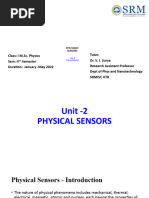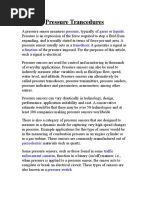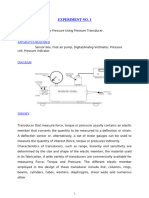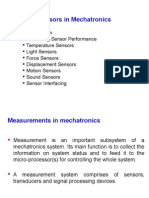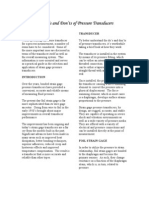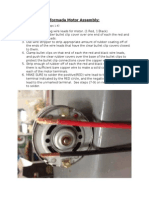Sensors Exercise
Uploaded by
Varden GutiérrezSensors Exercise
Uploaded by
Varden GutiérrezMeasurement and Instrumentation
Marisol Martínez Alanís, PhD
Sensor selection
You are asked to design an instrument that is capable of measuring pressure inside
a cylinder that contains an unknown, pressurized gas.
a. Which sensor do you think would be the most appropriate for the
measurement? Use a diagram to explain how you would place the
sensor inside cylinder and, if necessary, add any other components
you would need to perform the measurement.
A pressure sensor would be the most appropriate instrument for measuring
the pressure inside a cylinder containing an unknown, pressurized gas. There
are various types of pressure sensors available, including piezoelectric,
capacitive, and strain gauge sensors. The specific type of pressure sensor
chosen would depend on factors such as the range of pressures to be
measured and the accuracy required. To perform the measurement, in
addition to the pressure sensor, we would also need some supporting
components such as a power source, signal conditioning circuitry, and a
display or output device to display the measured pressure. The signal
conditioning circuitry would convert the output signal of the pressure sensor
to a suitable format that could be read by the output device or further
processed by a microcontroller or computer.
b. Compare the sensor you chose with two other sensors that are also
capable of measuring pressure. Mention advantages and
disadvantages of each of the sensors and justify the choice of your
sensor.
Temperature sensor: The temperature of the gas inside the cylinder can
affect the pressure measurement. Therefore, it may be necessary to measure
the temperature of the gas as well. This can be done using a temperature
sensor such as a thermocouple or a resistance temperature detector (RTD).
The temperature measurement can be used to correct any temperature-
dependent errors in the pressure measurement.
Gas sensor: Depending on the application, it may be important to know the
composition of the gas inside the cylinder. This can be done using a gas
sensor such as a gas chromatograph or a mass spectrometer. These sensors
can detect the presence of specific gases and provide information on their
concentration. This information can be used to identify the gas inside the
cylinder and to ensure that it is safe to handle.
c. You want to add an element that improves the sensitivity of the sensor,
specifically, a Wheatstone bridge like the one shown in Figure 1. What
UNIVERSIDAD ANAHUAC MEXICO
School of Engineering
January – May 2023
1/3
Measurement and Instrumentation
Marisol Martínez Alanís, PhD
configuration would you use for the bridge to improve the sensitivity?
Explain your choice and perform the necessary calculations to compare
the output voltage obtained against the input voltage (sensor voltage),
to demonstrate how sensitivity improves.
To improve the sensitivity of a strain gauge pressure sensor, we can use a
Wheatstone bridge circuit. The Wheatstone bridge circuit consists of four
resistors, with the strain gauge connected in one of the arms of the bridge.
The output voltage of the Wheatstone bridge is proportional to the difference
in resistance between the two arms of the bridge. By connecting the strain
gauge in one of the arms of the bridge, we can amplify the change in
resistance due to the pressure applied to the gauge.
To further improve the sensitivity of the Wheatstone bridge circuit, we can
use a quarter-bridge configuration, where the strain gauge is connected in
series with a fixed resistor, forming one arm of the bridge. This configuration
provides a larger change in resistance for a given change in pressure,
compared to a full-bridge configuration where all four arms of the bridge are
composed of strain gauges.
To calculate the output voltage of the Wheatstone bridge circuit, we can use
the formula:
Vout = (R2/R1 + R2) * Vexcitation * (ΔR/R)
where R1 and R2 are the two fixed resistors in the bridge, Vexcitation is the
excitation voltage supplied to the bridge, ΔR is the change in resistance of
the strain gauge due to the pressure applied, and R is the nominal resistance
of the strain gauge.
Assuming a quarter-bridge configuration with a fixed resistor of 350 Ω and a
nominal resistance of the strain gauge of 120 Ω, we can calculate the change
in output voltage for a change in resistance of 0.1 Ω, which corresponds to a
pressure change of approximately 1 psi:
Vout = (350/120 + 350) * 5 * (0.1/120)
Vout = 0.77 mV
If we compare this to the output voltage obtained from the strain gauge alone,
assuming a sensitivity factor of 2.0 mV/V/psi and an excitation voltage of 5
V, the change in output voltage for a pressure change of 1 psi would be:
Vout = 5 * 2.0 * (1/psi)
Vout = 10 mV
UNIVERSIDAD ANAHUAC MEXICO
School of Engineering
January – May 2023
2/3
Measurement and Instrumentation
Marisol Martínez Alanís, PhD
Therefore, using a Wheatstone bridge circuit with a quarter-bridge
configuration can provide a significant improvement in sensitivity compared
to a strain gauge alone.
d. If the sensor is affected by modifying inputs, what type of
compensation system could be implemented? Justify your answer.
If the sensor is affected by modifying inputs, such as changes in temperature or
humidity, a compensation system could be implemented to correct for these
effects and improve the accuracy of the pressure measurement.
One type of compensation system that could be used is temperature
compensation. Temperature can affect the sensitivity and offset of the pressure
sensor, leading to errors in the measurement. To compensate for these effects,
we can use a temperature sensor to measure the temperature of the sensor and
apply a correction factor to the pressure measurement. This can be done using
software or hardware, depending on the specific application.
Another type of compensation system that could be used is humidity
compensation. Changes in humidity can also affect the sensitivity and offset of
the pressure sensor, leading to errors in the measurement. To compensate for
these effects, we can use a humidity sensor to measure the humidity of the
environment and apply a correction factor to the pressure measurement. This
can also be done using software or hardware, depending on the specific
application.
In addition to temperature and humidity compensation, other types of
compensation systems may also be used depending on the specific
requirements of the application. These could include compensation for vibration,
shock, or other environmental factors that may affect the measurement. The
specific compensation system chosen would depend on the specific application
and the types of inputs that are likely to affect the sensor.
Figure 1.
UNIVERSIDAD ANAHUAC MEXICO
School of Engineering
January – May 2023
3/3
You might also like
- AOE3054-Chapter 2-Experiment Method (2)No ratings yetAOE3054-Chapter 2-Experiment Method (2)21 pages
- Different Types of Sensors.: Thermally Sensitive Resistor An NTC ThermistorNo ratings yetDifferent Types of Sensors.: Thermally Sensitive Resistor An NTC Thermistor14 pages
- Pressure Sensor: Improve This Article Adding Citations To Reliable SourcesNo ratings yetPressure Sensor: Improve This Article Adding Citations To Reliable Sources9 pages
- Princess Sumaya University For Technology: Differential Pressure Sensor in (BMS)No ratings yetPrincess Sumaya University For Technology: Differential Pressure Sensor in (BMS)5 pages
- An Introduction To Pressure Sensor by Soumen DasNo ratings yetAn Introduction To Pressure Sensor by Soumen Das2 pages
- Malaviya National Institute of Technology, Jaipur: Submitted To-Dr. Shiv Om MeenaNo ratings yetMalaviya National Institute of Technology, Jaipur: Submitted To-Dr. Shiv Om Meena15 pages
- Pressure Sensor: Types of Pressure MeasurementsNo ratings yetPressure Sensor: Types of Pressure Measurements5 pages
- SOC Nanobased Integrated Wireless Sensor SystemNo ratings yetSOC Nanobased Integrated Wireless Sensor System10 pages
- Unit II Overview of Sensors, Transducers and Their Characteristics SpecificationsNo ratings yetUnit II Overview of Sensors, Transducers and Their Characteristics Specifications29 pages
- 4 Biomedical Measurements and Transducers FullNo ratings yet4 Biomedical Measurements and Transducers Full10 pages
- Stress Gauge: By, V.Shanmukha Priya 20082333No ratings yetStress Gauge: By, V.Shanmukha Priya 2008233330 pages
- Vibrating Sensor:: Piezoelectric Effect Pressure Acceleration Strain Force ElectricalNo ratings yetVibrating Sensor:: Piezoelectric Effect Pressure Acceleration Strain Force Electrical7 pages
- Measurement of Atmospheric Pressure: 3.1 GeneralNo ratings yetMeasurement of Atmospheric Pressure: 3.1 General24 pages
- Introduction To Sensors in MechatronicsNo ratings yetIntroduction To Sensors in Mechatronics20 pages
- linquip.com-Pressure-Transducer-Definition-Working-Principle-and-TypesNo ratings yetlinquip.com-Pressure-Transducer-Definition-Working-Principle-and-Types9 pages
- System Board, Baseboard, Planar Board or Logic Board, or Colloquially, A Mobo) Is TheNo ratings yetSystem Board, Baseboard, Planar Board or Logic Board, or Colloquially, A Mobo) Is The5 pages
- Specification and Maintenance Manual: Sequence Flashing Lights (SFL)No ratings yetSpecification and Maintenance Manual: Sequence Flashing Lights (SFL)13 pages
- Total Rewinding and Reconditioning of 3KW MotorNo ratings yetTotal Rewinding and Reconditioning of 3KW Motor5 pages
- Pull-Safe PS-P (Polybutylene Terephthalate (PBT) .Polycarbonate (PC) )No ratings yetPull-Safe PS-P (Polybutylene Terephthalate (PBT) .Polycarbonate (PC) )2 pages
- 55174A92 QS II Basic Model With ADSU (Diktron) User Manual ENNo ratings yet55174A92 QS II Basic Model With ADSU (Diktron) User Manual EN28 pages
- Lubrificador Peças - Ms6-Loe-38-R - FestoNo ratings yetLubrificador Peças - Ms6-Loe-38-R - Festo3 pages
- Technical Parameters of Combined Scroll Air CompressorNo ratings yetTechnical Parameters of Combined Scroll Air Compressor5 pages
- Abb Acs880 07 VFD 750 HP To 3750 HP Hardware ManualNo ratings yetAbb Acs880 07 VFD 750 HP To 3750 HP Hardware Manual270 pages
- The Dos and Donts of Pressure Transducers DyniscoNo ratings yetThe Dos and Donts of Pressure Transducers Dynisco5 pages
- T170R Applanation Tonometer Structure and Specification: User ManualNo ratings yetT170R Applanation Tonometer Structure and Specification: User Manual2 pages
- Fourth Quarterly Examination in Tle Sy 2018-2019No ratings yetFourth Quarterly Examination in Tle Sy 2018-20193 pages
- 3 - MS-Installation of Distribution Boards & SMPNo ratings yet3 - MS-Installation of Distribution Boards & SMP7 pages



